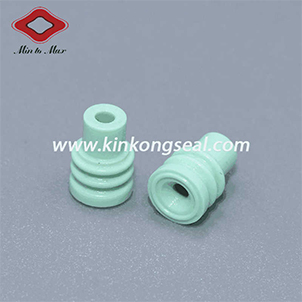Nov. 11, 2020
Characteristics of silicone
The basic structural unit of organic silica gel is composed of silicon-oxygen chain links, and the side chain is connected to various other organic groups through silicon atoms.
Therefore, the structure of the organic silicon coating material contains both "organic groups" and "inorganic structures". This special composition and molecular structure make it integrate the characteristics of organic substances and the functions of inorganic substances. The outstanding properties of silicone products include:
1.1 High temperature resistance
Since the molecular structure of organic silicon has structural characteristics similar to inorganic polymers, its bond energy is very high, so it has excellent heat resistance.
The use temperature of rubber-type silicone is about 250℃, and resin-type silicone can be used for a long time at 350℃.
1.2 Low temperature resistance
The rubber-type silicone has long bonds, large bond angles, and is very soft. Its glass transition temperature is generally around -123℃, and can be used for a long time in the range of -50 to 250℃. Special products can be used in the range of -100 to 300℃, such as silicone rubber containing 7.5 (molar content) phenyl groups. It remains elastic at -112°C.
1.3 Weather resistance
There are no double bonds in the main chain of organic silica gel, so it is not easily decomposed by ultraviolet light and ozone. Long-term exposure to outdoors or in an environment with high ozone concentration will not cause cracks and viscous creep, and the physical and electrical properties are basically unchanged. Resin-type organic silica gel will not turn yellow even under strong ultraviolet radiation, and its color can remain unchanged for many years.
1.4 Hydrophobicity
In organosilica gel, the methyl group is connected to the silicon atom by a bond, thereby increasing the free space for rotation, and the hydrogen atom on the methyl group that is arranged outwards repels the hydrogen atom of the water, making the water molecule difficult to be hydrophilic. The oxygen is close to, so it has strong hydrophobicity. The methyl hydrogen polysiloxane or polyethyl hydrogen siloxane containing Si-H bond has reactivity and strong orientation, and can be cross-linked into a hydrophobic film under the action of a catalyst at low temperature.
1.5 Air permeability
Because the polysiloxane molecule has a spiral structure and large free space, the silicone rubber coating film has good gas and vapor permeability, such as the permeability of nitrogen, oxygen, carbon dioxide and other gases in the air at room temperature The rate is 30 to 50 times higher than that of natural rubber, and it is selective. Therefore, it has been widely used in gas and water vapor separation membranes, artificial heart-lung machines, oxygen-enriching devices, etc.
1.6 Low surface tension and low surface energy
The main chain of organosilicon is very flexible, and its intermolecular force is much weaker than that of hydrocarbons. Therefore, it has lower viscosity than hydrocarbons of the same molecular weight, weak surface tension, low surface energy, and strong film-forming ability. This low surface tension and low surface energy are the main reasons for its many applications: hydrophobic, defoaming, foam stability, anti-sticking, lubrication, glazing and other excellent properties.
1.7 Electrical insulation performance
Silicone products have good electrical insulation properties. Their dielectric loss, voltage resistance, arc resistance, corona resistance, volume resistivity and surface resistivity are among the best in insulating materials, and their electrical properties are affected by temperature and frequency. The impact is very small. Therefore, they are a kind of stable electrical insulating materials, which are widely used in the electronics and electrical industries. In addition to excellent heat resistance, silicone also has excellent water repellency, which is a guarantee for high reliability of electrical equipment used in wet conditions.
1.8 Physiologically inert (non-toxic)
Silicone elastomers are correctly selected and reliable cross-linking and catalytic systems. The fully cross-linked products are non-toxic and harmless, and can be used in the food and medical industries.

Silicone Automotive Cable Seals
The development trend of organic silica gel
To sum up, because organic silica gel has many excellent physical and chemical properties, it can be used in many occasions and environments, and it will play an important role in more fields. In the future, organic silica gel will achieve rapid development in the following aspects.
(1) Improvement of curing method: development from traditional thermal curing to radiation curing and microwave curing. Currently, UV-curable silicone anti-sticking agents and optical fiber coatings have made important progress.
(2) The introduction of functional groups: replacing commonly used methyl and phenyl groups with amino groups, epoxy groups, allyl groups, hydroxyl groups, etc., can change the physical properties and chemical reactivity of organic silica gels in a wide range.
(3) Composite use with other materials: Although silicone has many excellent properties, it also has disadvantages such as low strength and poor adhesion to the substrate. Through grafting with epoxy, acrylic, polyurethane and other resins, block Modification of copolymerization method can achieve the effect of complementary performance.
We are the Silicone Single Wire Seal manufacturer. Our company provides high-quality silicone Automotive Cable Seals. If you are interested in our products, please feel free to contact us.
Tel: +86 13705057546
E-mail: info@kinkong.com
Add: #27 Hengjing Xiyi Road, Liushi Town, Yueqing City, Zhejiang Province, 325604, China.
Copyright © Min To Max All Rights Reserved |